تمثال إبيه إيل
| Statue of Ebih-Il | |
|---|---|
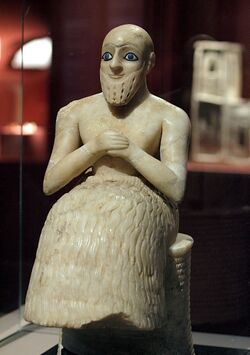 Statue of Ebih-Il, superintendent of Mari | |
| الخامة | Alabaster, shells, lapis lazuli, bitumen |
| الإرتفاع | 52.5 centimetres (20.7 in) |
| العرض | 20.6 centimetres (8.1 in) |
| العمق | 30 centimetres (12 in) |
| أنشئت | ح. 2400 BC |
| الفترة/الثقافة | Sumerian |
| أُكتشفت | 1934 |
| الموقع الحالي | Musée du Louvre, Paris Heilongjiang Art Museum, Harbin (downsized replica) |
| الهوية | AO 17551 |
The Statue of Ebih-Il is a 25th-century BC statue of the praying figure of Ebih-Il (𒂗𒋾𒅋, EN-TI-IL, e-bih-il),[1][2] superintendent of the ancient city-state of Mari in modern eastern Syria. The statue was discovered at the Temple of Ishtar in Mari during excavations directed by French archaeologist André Parrot. It is made of gypsum, with inlays of schist, shells and lapis lazuli. The statue is displayed in the Musée du Louvre. It has been described as "a masterpiece by virtue of its craftsmanship, state of preservation, and expressive style."[3]
Overview
The statue, made of translucent smooth alabaster, depicts the figure of a man seated on a wicker hassock. He is shown in a praying posture with hands clasped against his chest conveying his devotion to the deity.[3]
The man's head is shaved. His long beard is composed of vertical curls and has drilled holes drilled formerly inlaid with another, now-lost material.[3] The beard accentuates the figure's cheeks and finely sculpted lips that convey a half-smile. The figure's staring blue eyes were crafted with particular care and detail. Flakes of schist, shells and lapis lazuli form the eyelashes and eyelids, cornea and iris, respectively.[4] The lapis lazuli inlays were imported from as far east as Afghanistan.[3]
The figure has a bare torso and thin waist. The hands are clasped against the chest, with the left hand closed and placed inside the right hand.[4] The figure's only dress is the Sumerian-style ceremonial kaunakes skirt. This elaborate fleece skirt appears to be made from animal hide (probably sheepskin or goatskin) as evidenced by the presence of a tail at the back.[3] The figure's feet are missing but their attachment piece is still showing under the dress.[4]
The inscription in proto-cuneiform signs on the rear, which identifies the work, reads: "Statue of Ebih-Il, the superintendent, dedicated to Ishtar Virile."[3]
𒊨 𒂗𒋾𒅋 𒉡𒌉 𒀭𒈹𒍑 𒊕𒄸𒁺[5]
dul, Ebih-il, nu-banda, dIštar Nita, sarig[6]
"This statue, Ebih-il, the overseer, to Ishtar (?), he dedicated"
الحفريات
The statue was discovered in two parts by a French excavation team under André Parrot.[9] The head was found on the pavement of the outer court of the Temple of Ishtar,[4] and a few meters away the body along with a smaller statue of King Lamgi-Mari.[9] The left arm and elbow were broken, and the base of the right elbow was shattered.[4] The statues were the first major discovery of the Mari excavations started winter 1933,[10] the head found 22 January 1934, the body 23 January 1934.[11]
Details of the statue
A profile of the statue showing the seated posture and the kaunakes skirt
Dedication of the statue in Proto-cuneiform script: "Ebih-Il, nu-banda (𒉡𒌉, nu-banda, "overseer"),[12] offered his statue to Ishtar Virile"
The name "Ebih-Il" (𒂗𒋾𒅋, EN-TI-IL)[13] on the statue, with the corresponding standard Sumero-Akkadian cuneiforms.[1]
انظر أيضاُ
| مملكة ماري |
|---|
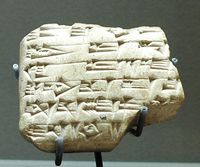 |
| الملوك |
| الآثار |
References
Citations
- ^ أ ب "Sumerian Dictionary". oracc.iaas.upenn.edu.
- ^ THUREAU-DANGIN, F. (1934). "Inscriptions Votives Sur des Statuettes de Maʾeri". Revue d'Assyriologie et d'archéologie orientale. 31 (3): 143. ISSN 0373-6032. JSTOR 23297288.
- ^ أ ب ت ث ج ح Iselin, Claire. "Ebih-Il, the Superintendent of Mari". Musée du Louvre. Retrieved 10 October 2012.
- ^ أ ب ت ث ج Parrot, 1935, p. 26.
- ^ The first character is 𒊨 dul3 for "statue" ("plaster") in "Statue inscription of Ebil-Il"., previously given as 𒊕 şalam by Spycket. A related reference: Lecompte, Camille (2014). Le sanctuaire du "Seigneur du pays". Cahier des Thèmes transversaux.
- ^ Written 𒊕𒄸𒁺 sa12rig9 "to donate a statue", rather than the later (Babylonian) 𒅖𒊒𒊌 išruk "to donate". For reference: "Statue inscription of Ebil-Il"., "Statue of Ikun-Shamash". CDLI.
- ^ Spycket, Agnès (1968). Les Statues de culte dans les textes mésopotamiens: des origines à la Ire. dynastie de Babylone (in الفرنسية). J. Gabalda et Cie. p. 36.
- ^ "Statue inscription of Ebil-Il".
- ^ أ ب Cluzan; Lecompte, 2011, p. 5.
- ^ Parrot, 1935, p. 1.
- ^ "Voués à Ishtar. Syrie, janvier 1934: André Parrot découvre Mari" (PDF).
- ^ "Sumerian Dictionary". oracc.iaas.upenn.edu.
- ^ THUREAU-DANGIN, F. (1934). "Inscriptions Votives Sur des Statuettes de Maʾeri". Revue d'Assyriologie et d'archéologie orientale. 31 (3): 143. ISSN 0373-6032. JSTOR 23297288.
Bibliography
- Cluzan, Sophie; Lecompte, Camille; Musée du Louvre. Département des antiquités orientales (2011). Ebih-Il (in الفرنسية). Paris: Louvre éditions. ISBN 9782757205099.
- Parrot, André (1935). "Les fouilles de Mari (Première campagne)" (PDF). Syria (in الفرنسية). Institut français du Proche-Orient. 16 (1): 1–28. doi:10.3406/syria.1935.8338.
- CS1 الفرنسية-language sources (fr)
- Short description is different from Wikidata
- 25th-century BC works
- 3rd-millennium BC sculptures
- Sculpture of the Ancient Near East
- Syrian art
- Archaeological discoveries in Mari, Syria
- Near Eastern and Middle Eastern antiquities in the Louvre
- Alabaster
- Sumerian art and architecture
- 1934 archaeological discoveries
- Early Dynastic Period (Mesopotamia)
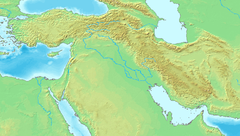
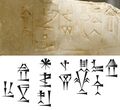






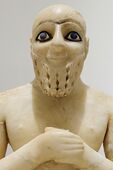
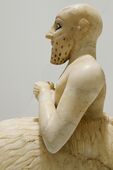

![Dedication of the statue in Proto-cuneiform script: "Ebih-Il, nu-banda (𒉡𒌉, nu-banda, "overseer"),[12] offered his statue to Ishtar Virile"](/w/images/thumb/4/41/Ebih-Il_Louvre_AO17551_n07.jpg/170px-Ebih-Il_Louvre_AO17551_n07.jpg)
![The name "Ebih-Il" (𒂗𒋾𒅋, EN-TI-IL)[13] on the statue, with the corresponding standard Sumero-Akkadian cuneiforms.[1]](/w/images/thumb/a/a8/Ebih-Il_%28name%29.jpg/170px-Ebih-Il_%28name%29.jpg)
